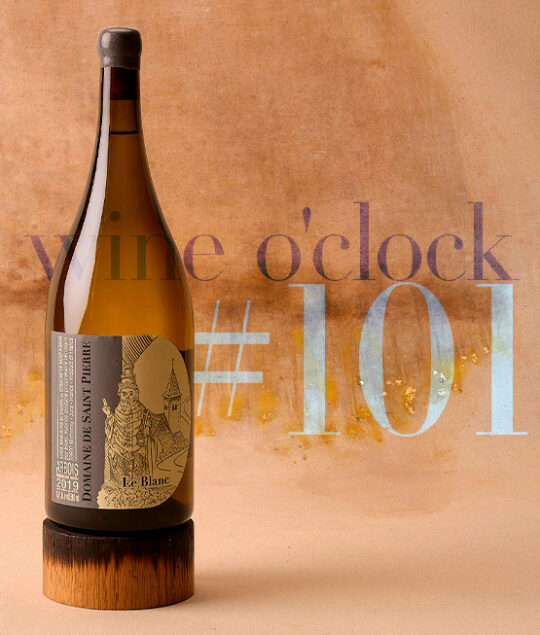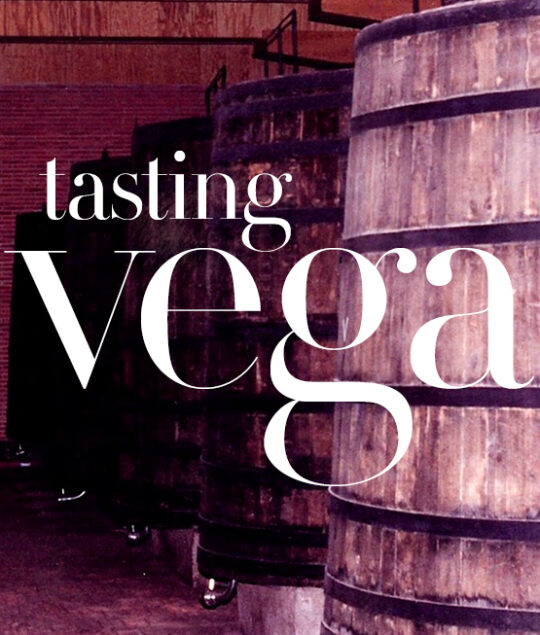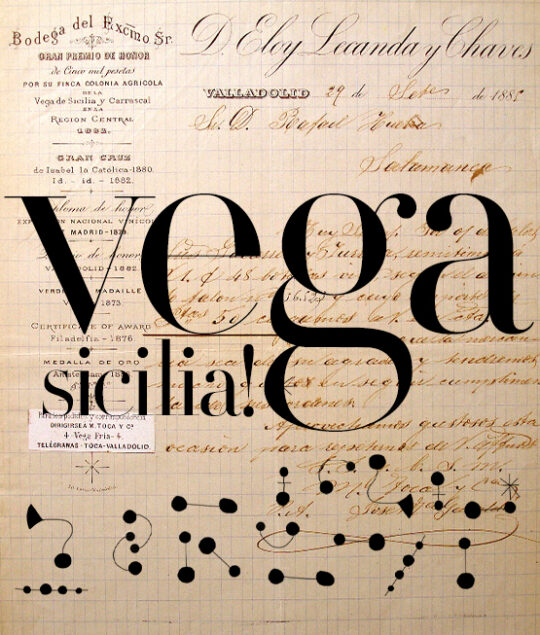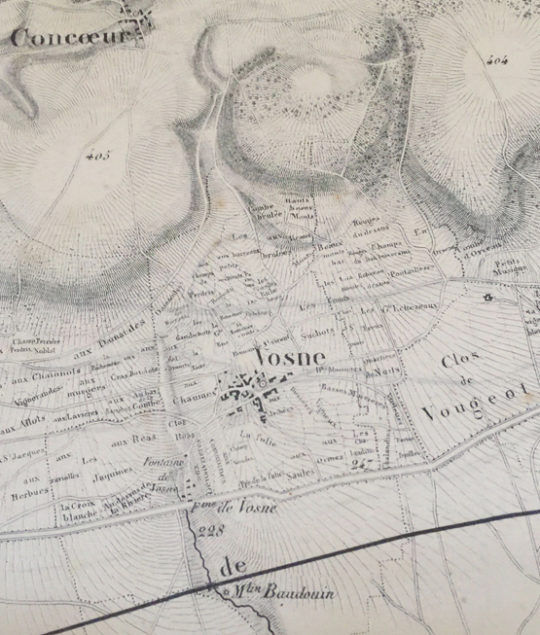
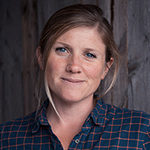
By Julie Carpentier
5 climats & 3 men… each his own outstanding vintage
Clos-Vougeot Grand Cru
A symbolic place of Burgundy winemaking, the Château du Clos de Vougeot and its enclosed vineyards, the property of Cîteaux Abbey, are intimately connected to the evolution of winemaking in the Côte de Nuits. After the French Revolution, the Church properties were sold off to the highest bidder, and the Château and the vines changed hands several times. On March 1, 1920 René Engel acquired a parcel in the Clos de Vougeot, at the famous sale that broke up the property of Léonce Bocquet, a local benefactor, who died in 1913. The acquisition was of 1 hectare, 36 ares and 96 centiares, in the very highly regarded Marei (Maret) Haut section, halfway up the hillside. This parcel of gravelly clay and limestone soil, standing in the heart of the mythical Cistercian enclosure, located just below the Château, has illustrious neighbours, including Drouhin-Laroze and Bouchard.
“One hectare, thirty-six ares and ninety- six centiares in the part of the Clos de Vougeot known as Les Marets Hauts, adjoining to the north side Monsieur Alexandre Drouhin, to the south the widow Madame Noellat, and to the east a track.”
It was from these very ancient vines that René, then Pierre and finally Philippe in turn produced the Grand Cru that is acknowledged as one of the best wines of the appellation. The Clos de Vougeot of Domaine René Engel has a deep velvety character, enormous elegance, remarkable finesse and is bursting with fruit when young. When laid down, it develops a complex bouquet with notes of spices, blackcurrants and undergrowth, elegantly combined in a wine with a rounded tannic structure and remarkable aromatic persistence.
Outstanding vintages
René — 1923.
Ranked by René Engel as a very good year, just as 1921, 1926 and 1929.
Pierre — 1955.
Year of the birth of Philippe Engel.
Philippe — 2002.
This vintage embodies the perfect balance between the mature grapes and their delicate acidity.
Échezeaux Grand Cru
A Grand Cru that flourishes at the foot of the valley of Orveaux near the village of Flagey, the name of the Échezeaux wines achieved such fame that in 1886 it was added to the name of the commune, becoming Flagey-Échezeaux. On a gently sloping terroir that alternates Comblanchien limestone and marls, the red soils of Echézeaux (characterised by a rich presence of iron oxide) are a favourite of Pinot Noir grapes.
“The En Ouvreaux vines adjoining to the north side a track, to the south a footpath, to the east Gaudemet and to the west Jayer and one other.”
The half-hectare of vines successively worked on by the trilogy of men who ran the Engel estate is located in the “ En Orveaux ” (or Ouvreaux) sub-plot. Some of the Échezeaux vines belonging to the Engels are very old – almost 80 years in some cases, at the time that Philippe was in charge. This sheltered spot was the favoured choice of Philippe and his team for their lunchtime breaks during the seasonal labours. An Échezeaux with a lot of panache and depth, both rich and pure. It presents a distinctive florality and, vintage after vintage, expresses fruit that maintains great generosity.
Outstanding vintages
René — 1922.
Pierre — 1970.
Philippe — 1985.
Seeing that the grapes were perfectly ripe and healthy, and despite Philippe’s concerns about temperature spikes during the fermentation phase, his grand-father René encouraged him to let nature follow its course.
Grands-Échezeaux Grand Cru
One of the gems of Domaine Engel is unquestionably its Grand Cru Grands-Échezeaux. The heart of this vine, planted in the 1930s (the vine stocks were on average 75 years old at the time of the Engel-Pinault sale), combines two plots that represent precisely 0.5 hectare of the 7.5 hectares that comprise the appellation, recognised by decree in 1937. The Grands-Échezeaux plot benefits from deep and well-drained soils as well as an ideal aspect offering a perfect balance between sunshine and rapid clearing of the morning mists.
“Vines adjoining Malbranche to the north, Pillet to the west, and a track to the south and east.”
The Grands-Échezeaux produced by Domaine Engel marry to perfection the distinguishing features of this age-old terroir – finesse, fruit, depth, complexity. Less amplitude than other Grands Crus produced by the estate, but greater length. Less powerful, but greater subtlety combined with an attractive minerality and silky tannins.
Outstanding vintages
René — 1923.
Pierre — 1978.
A mythical vintage of the Côte de Nuits.
Philippe — 2004.
Philippe Engel’s final vintage; a year offering all the qualities of a Grands-Échezeaux for long cellaring – well-structured fruit, mature grapes, attractive acid structure, resulting in wines with real complexity and remarkable length.
Vosne-Romanée 1er Cru Les Brulées
The Vosne-Romanée wine-growing area includes several Premiers Crus, and Les Brulées is without question one of its jewels. With 1.1741 hectares of vines growing in the soils of the hillside, where the soil is richer and the movement of air masses subjects the plants to sharp temperature variations, the Vosne-Romanée 1er Cru Les Brulées of Domaine René Engel is a combination of three small adjacent parcels and a larger parcel (0.93 ha) that has belonged to the family for many years.
“Vines and land adjoining Gaudemet to the north, the Concœur track and Monsieur Engel to the south, Jayer and Engel to the east, and Pelletier and others to the west.”
This hillside with its lean and stony ground conducts cool winds and ensures good ventilation of the fruit in summer. This is one of the hottest spots around the village of Vosne-Romanée, where the heat generated by the glare from the stones increases solar gain. About forty years old during Philippe’s time, the estate’s Vosne-Brulées vineyards produce a wine that, regardless of the vintage, unfailingly combines power, a velvety character and aromatic complexity (one that recalls their noble neighbour “Richebourg”). A silky mouthfeel and a beautiful ripe fruit, yet enhanced by the chiselled acidity of this microclimate, and the mineral and spicy fragrances characteristic of Vosne-Brulées. Richness, concentration, length, boldness, with a very attractive balance. A power worthy of a Grand Cru.
Outstanding vintages
Philippe — 2000.
In 2000 Philippe Engel produced magnificently balanced wines and the Vosne-Brulées are a remarkable example, offering considerable cellaring potential.
Vosne-Romanée
“There are no ordinary wines in Vosne”, Courtepée used to say. Often described as the “Pearl” of the Burgundy Côtes, the beautiful village of Vosne-Romanée, steeped in a rich history, is the cradle of many famous wines as well as the anchoring-point of the Engel family. Built in the early 1900s by Paul Faiveley and then bequeathed to René, the main estate building located at Place de la Mairie has an extraordinary vaulted cellar in its basement where three successive generations – René, Pierre and Philippe – worked to make wine from the grapes grown on the village appellation “Vosne-Romanée”.
“Les Chalandins, land and wines of forty-eight centiares adjoining Monsieur Engel to the north, Chopin to the east, Fortier to the south, and Faiveley to the west.”
A string of parcels makes up the 2.868 hectares of Vosne-Villages (the area under cultivation at the time of the Engel-Pinault sale, with vines aged an average of 50 years). The Vosne-Romanée Village produced by Domaine Engel has the reputation of being a superbly well-balanced wine, year after year. With an attractive precision and striking depth, reflecting the quality of the terroir it offers both fruit and lightness, together with body and length in the mouth.
Basses-Maizières, Aux Communes, Les Vigneux, Les Chalandins… these plots from the lower sector of Vosne are combined in a blend to offer wines with a great deal of depth (like the soils), and readiness for ageing (to refine and increase fruit density). The tannic structure (power and finesse combined) of these Vosne-Villages is accompanied by an aromatic palette to the nose (black pepper, sandalwood, incense and leather) and fluid and fruity on the palate, or even floral in some fresher vintages.
Outstanding vintages
René — 1921.
One of the greatest early 20th century vintages in Burgundy.
Pierre — 1962.
Philippe — 2003.
